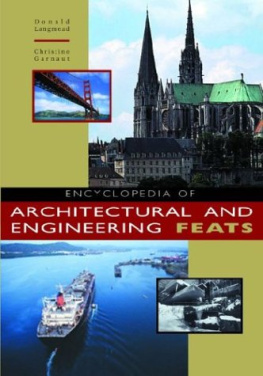A
Abomey Royal Palaces
Benin, Africa
The Royal Palaces of Abomey in the West African Republic of Benin (formerly the Kingdom of Dahomey), on the Gulf of Guinea, are a substantial reminder of a vanished kingdom. From 1625 to 1900 Abomey was ruled by a succession of twelve kings. With the exception of Akaba, who created a separate enclosure, each built a lavish cob-wall palace with a high, wide-eaved thatched roof in the 190-acre (44-hectare) royal grounds, surrounded by a wall about 20 feet (6 meters) high. There are fourteen palaces in all, standing in a series of defensible courtyards joined by what were once closely guarded passages. Over centuries, the complexreally a a city within a citywas filled with nearly 200 square or rectangular single-story houses, circular religious buildings, and auxiliary structures, all made of unbaked earth and decorated with colorful bas-reliefs, murals, and sculpture; it was a major and quite unexpected feat of contextual architecture in a preliterate society.
According to tradition, in the twelfth or thirteenth century a.d. , Adja people migrated from near the Mono River in what is now Togo and founded a village that became the capital of Great Ardra, a kingdom that reached the zenith of its power about 400 years later. Around 1625 a dispute over which of three brothers should be king resulted in one, Kokpon, retaining Great Ardra. Another, Te-Agdanlin, founded Little Ardra (known to the Portuguese as Porto-Novo). The third, Do-Aklin, established his capital at Abomey and built a powerful centralized kingdom with a permanent army and a complex bureaucracy. Intermarriage with the local people gradually formed the largest of modern Benins ethnic groups, the Fon, or Dahomey, who occupy the southern coastal region. Abomey is their principal town.
The irresistible Fon armiesthey included female warriorscarried out slave raids on their neighbors, setting up a trade with Europeans. By 1700 about 20,000 slaves were sold each year, and the trade became the kingdoms main source of wealth. Despite British efforts to stamp it out, it persisted, and Dahomey continued to expand northward well into the nineteenth century. King Agadja (17081732) subjugated much of the south, provoking the neighboring Yoruba kingdom to a war, during which Abomey was captured. The Fon were under Yoruba domination for eighty years from 1738. In 1863, in a bid to balance Fon power, Little Ardra (the only southern town not annexed by Agadja) accepted a French protectorate. France, fearing other European imperialists, tried to secure its hold on the Dahomey coast. King Behanzin (18891893) resisted, but France established a protectorate over Abomey, exiled him, and made his brother, Agoli-Agbo, puppet king under a colonial government. By 1904 the
designed to resist oscillation induced by the wind. The main cables, fixed in the massive anchorages and passing through the tops of towers, were spun from 290 strands of galvanized steel wirea newly developed technologyeach containing 127 filaments about 0.2 inch (5 millimeters) in diameter. Their high strength does away with the need for double cables, and because they achieve a sag:span ratio of 1:10, the height of the main towers could be reduced. To prevent corrosion of the cables in the salt atmosphere, dehumidified air flows through a hollow inside them, removing moisture. The towers and the suspended structure are all finished with high-performance anticorrosive coatings to suit the demanding marine environment.

Akashi-Kaikyo Bridge; Kobe, Japan, 19881998.
From the main cables, polyethylene-encased, parallel-wire-strand suspension cables support the truss-stiffened girder that carries a six-lane highway with a traffic speed of 60 mph (100 kph). The preassembled truss members were hoisted to the deck level at the main towers, carried to their location by a travel crane, and connected; then the suspension cables were attached. This construction technique was chosen because it did not disrupt activity on the water, where 1,400 ships daily pass through the straits.
Further reading
Thomas, Mark. 2001. The Akashi-Kaikyo Bridge: Worlds Longest Bridge. New York: Rosen Publishing Group.
Alberobello trulli
Italy
The Murgia dei Trulli, with its communes of Martina Franca, Locorotondo, Cisternino, and Alberobello, is located in the Apulian interior at the upper part of the heel of Italy. Although trulli are scattered throughout

Durham Cathedral, Durham, England; architect(s) unknown, 10931133. Interior of nave, looking east toward choir.
Instead of groin vaults, the nave and choir (ca. 1104) of Durham Cathedral are covered using a revolutionary technique: the bays are framed by lateral, transverse, and diagonal beams or ribsforerunner of the steel- or concrete-framed buildings of modern timeswith panels of stone spanning the much smaller areas between them. The most exciting innovation among several at Durham, these are the first known examples of pointed ribbed vaults. The ribs carry their own weight and that of the stone roof to collection points above the piers, and the complex dynamic nature of the loads is thus cleverly resolved. It seems that the northern Italian clerics behind the development of Norman Christianity knew something of ribbed-vault construction, which the invaders took to England. Some sources believe that Lombard experiments mayand only mayhave been as early as 1080, but there are certainly no examples on such a large scale as Durham, which therefore preempts by almost a century the key to the dramatic Gothic constructional system.
The church consists of a western galilee, or Lady Chapel; an aisled nave with two western towers; transepts flanking a taller tower above the crossing; and an aisled chancel (which was reduced in length during the thirteenth century). The eight bays of the nave are divided by piers disguised as clusters of columns, alternating with massive circular columns. The same articulation can be found in the choir and transepts. On the face of each pier is a tall shaft rising from the floor that appears to carry the slightly pointed transverse arches that support the vault, nearly 80 feet (24 meters) above. At the triforium (second level), each arch of the arcade is subdivided into two, and on the clerestory (the highest level), arches are supported by a pair of freestanding columns. The nave vault is laterally braced by quadrant archesheralding the flying buttress of Gothic architectureconcealed in the triforium galleries. The substructures of the 218-foot-high (65.4-meter) central tower and much of the transepts were begun before 1096. The 155-foot-high (47-meter) vault of the crossing, not completed until the fifteenth century, is carried by four huge arches. The original roof of the choir was replaced by the present vault around 1250.
Like many medieval churches, Durham Cathedral has undergone alterations and additions (and, on occasion, what passed for restoration) through almost nine centuries. None has diminished the first impression of overwhelming power and stability experienced by the modern visitor when entering this fortress of God at the frontier of the Normans domain.
See also
Further reading
Shipley, Debra, and Angelo Hornak. 1990. Durham Cathedral. London: Tauris Parke Books.
Stranks, C. J. 1973.
Next page












